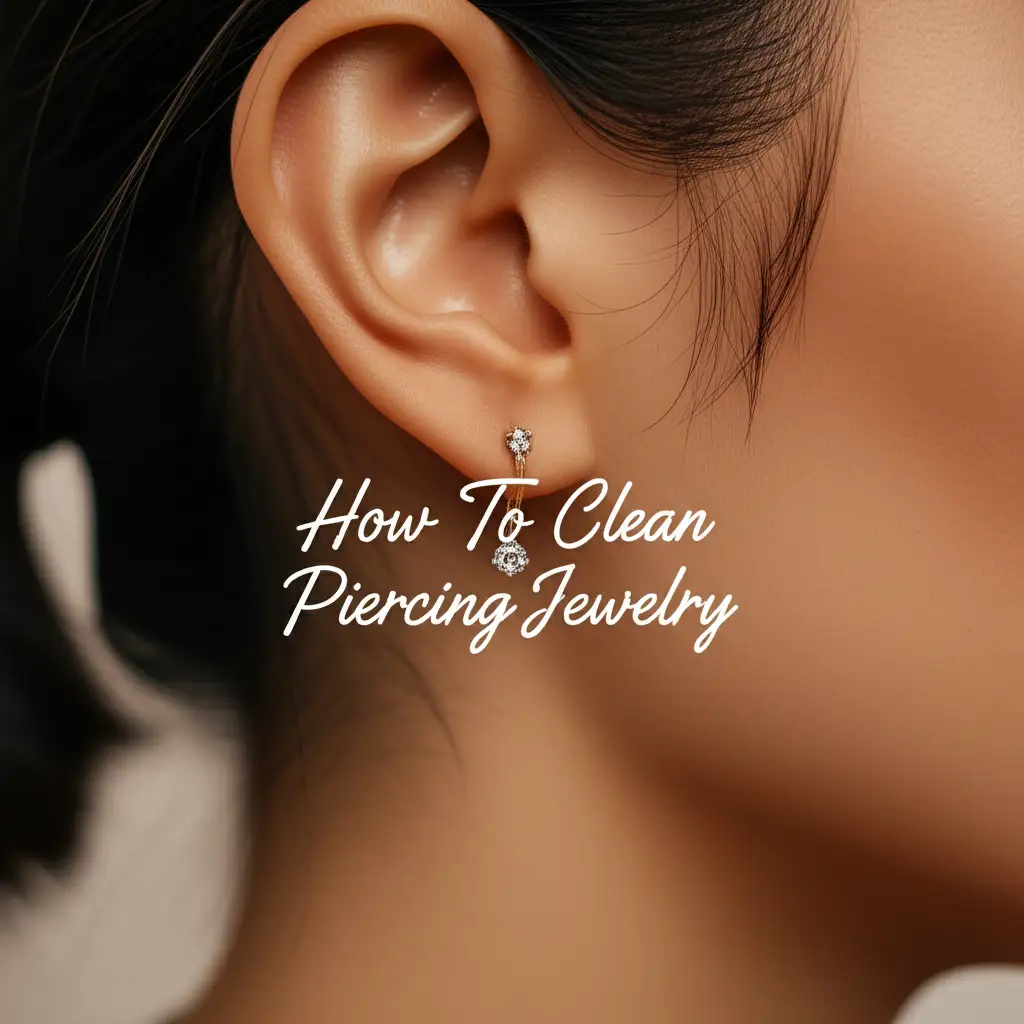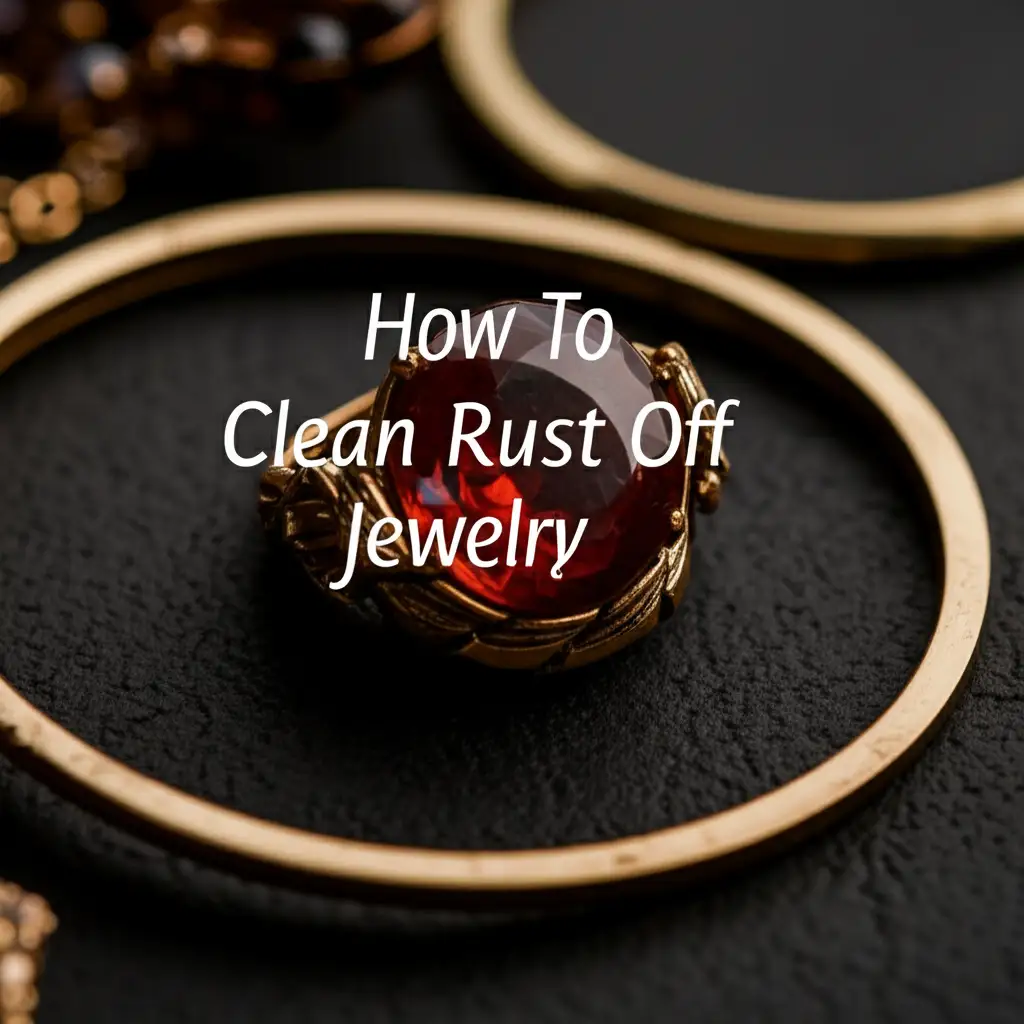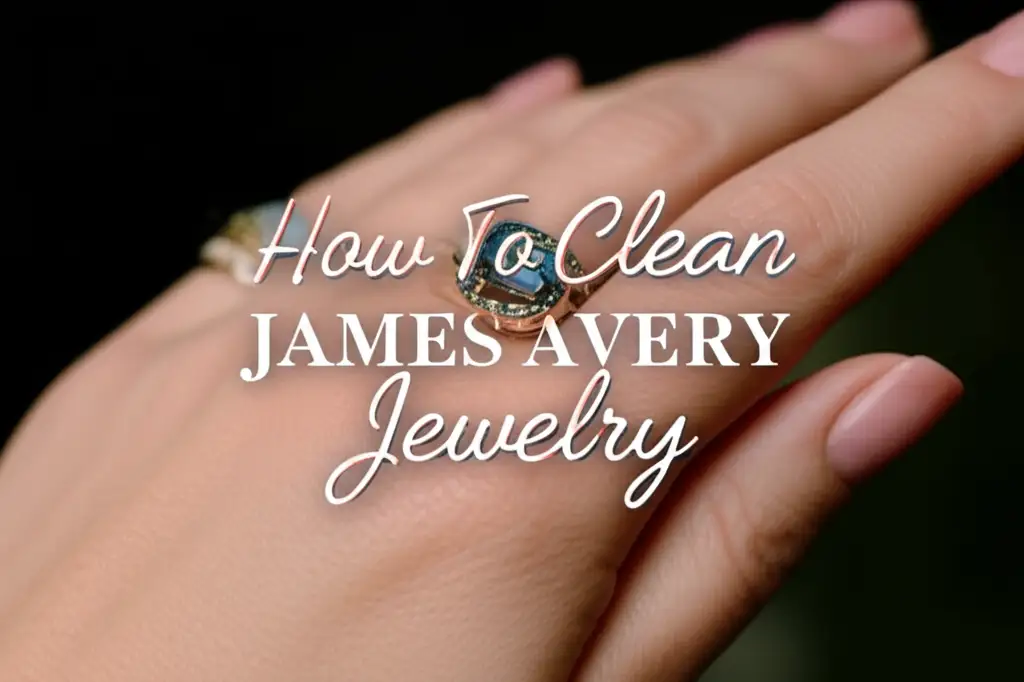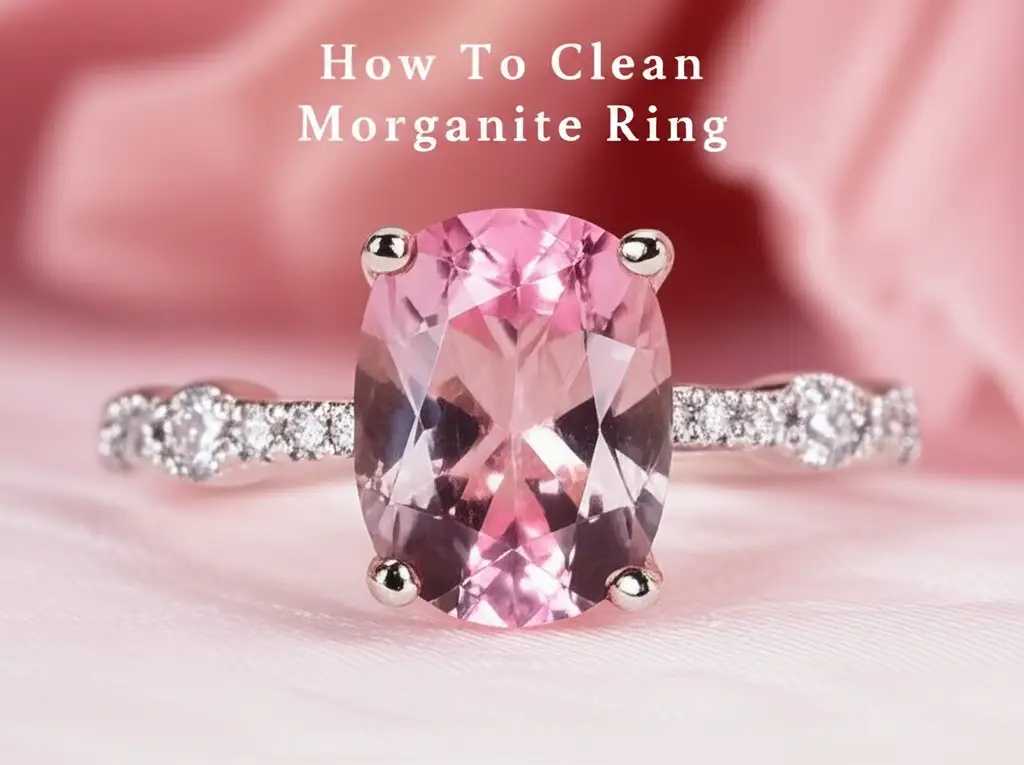· Jewelry Care · 16 min read
How To Clean Piercing Jewelry

Cleaning Piercing Jewelry: A Complete Guide
Keeping your piercing jewelry clean is very important. This practice maintains hygiene. It also helps your piercings stay healthy. Proper cleaning prevents infections and irritation. Dirty jewelry can cause many problems. It can lead to discomfort or more serious issues.
This guide will teach you how to clean piercing jewelry safely. We will cover different materials and methods. You will learn about general cleaning steps. We will also discuss specific care for various jewelry types. We will explain common mistakes to avoid. By the end, you will know exactly how to care for your piercing jewelry. This ensures your pieces look great and keep your skin happy.
Takeaway:
- Regularly clean piercing jewelry to prevent infection and irritation.
- Use gentle, body-safe solutions suitable for your jewelry material.
- Always wash hands before handling jewelry.
- Rinse thoroughly and dry completely after cleaning.
- Understand specific care needs for materials like surgical steel, titanium, gold, and acrylic.
How do you clean piercing jewelry?
You clean piercing jewelry using mild soap and warm water. For specific materials, use appropriate cleaners like saline solution or specialized jewelry dips. Always rinse thoroughly and dry completely. This removes debris, bacteria, and body oils, keeping your piercing healthy and jewelry sparkling.
Why Regular Cleaning of Piercing Jewelry Matters
Cleaning your piercing jewelry often is not just about keeping it shiny. It is a critical step for your health. Piercings are open wounds, especially when new. Even old piercings can become irritated. Jewelry collects skin cells, oils, and bacteria. This buildup can cause skin problems.
Regular cleaning helps prevent these issues. It stops bacteria from growing on the jewelry. This reduces the risk of infection. It also removes irritants that can cause redness or swelling. A clean piece of jewelry promotes good skin health around the piercing site. It keeps the area clear and allows it to heal well.
Think of your jewelry as an extension of your body. Just as you wash your skin, you need to clean the things that go inside your skin. This simple habit keeps your piercings safe and comfortable. It also extends the life of your jewelry. Dirty jewelry can corrode or lose its shine. Proper care maintains its quality.
Essential Tools and General Cleaning Steps
Before you begin to clean piercing jewelry, gather your supplies. You need a few basic items. These tools make the cleaning process easy and safe. Using the right tools prevents damage to your jewelry. They also ensure a thorough clean.
The essential tools include mild, unscented soap. Antibacterial liquid soap is a good choice. You will also need warm distilled or purified water. A soft-bristle toothbrush, like a child’s toothbrush, can be helpful for scrubbing. Lint-free cloths or paper towels are necessary for drying. Cotton swabs can help clean small crevices.
Here are the general steps for cleaning most piercing jewelry:
- Wash Your Hands: Always start with clean hands. Use antibacterial soap and warm water. This prevents transferring germs to your jewelry or piercing.
- Remove Jewelry (If Healed): Only remove jewelry from fully healed piercings. For new or healing piercings, clean the jewelry while it is still in place. Consult your piercer if unsure.
- Prepare Cleaning Solution: Mix a small amount of mild soap with warm water in a clean bowl. Avoid harsh chemicals or strong detergents.
- Soak Jewelry: Place the jewelry into the solution. Let it soak for a few minutes. This helps loosen any crust or debris.
- Gently Clean: Use a soft-bristle brush or cotton swab. Gently scrub the jewelry. Pay attention to threads, gems, and small parts.
- Rinse Thoroughly: Rinse the jewelry under warm, running distilled water. Make sure all soap residue is gone. Soap left on jewelry can irritate your skin.
- Dry Completely: Use a clean, lint-free cloth or paper towel. Air dry the jewelry if possible. Ensure no moisture remains, especially inside threaded areas. Moisture can lead to bacterial growth or material degradation.
Remember, patience is key. Do not rush the cleaning process. A careful approach ensures your jewelry is truly clean and safe to wear.
Cleaning Specific Piercing Jewelry Materials
Different jewelry materials require specific cleaning methods. Using the wrong cleaner can damage your pieces. It can also cause skin reactions. Understanding your jewelry’s material is the first step. This section details how to clean common piercing jewelry types.
Stainless Steel and Titanium
Surgical stainless steel and titanium are very popular for piercings. They are durable and body-safe. These metals resist tarnishing and corrosion. Cleaning them is relatively simple. Many piercers recommend them for initial piercings.
To clean these metals, use warm water and mild liquid soap. You can also use a saline solution. Soak the jewelry for a few minutes. Then, gently scrub it with a soft brush. Rinse it well under running water. Ensure all soap is gone. Dry it completely with a clean, lint-free cloth. Do not use abrasive cleaners or harsh chemicals. These can scratch the surface or compromise the material.
These materials are excellent for their inert properties. They do not react with body fluids. This helps prevent irritation and infection. Regular cleaning keeps them smooth and free of buildup. This ensures comfortable wear.
Gold and Gold-Plated Jewelry
Gold is another common material for piercing jewelry. It comes in various karats like 14k or 18k. Lower karats often contain other metals, which can affect cleaning. Gold-plated jewelry has a thin layer of gold over a base metal. This plating can wear off with harsh cleaning.
For solid gold, use warm water and a gentle, non-abrasive soap. Soak the jewelry for a short time. Lightly brush it with a soft toothbrush. Rinse it well. Dry it completely. You can also use specialized gold jewelry cleaners. Make sure they are safe for body jewelry. For more specific guidance on gold cleaning, you can refer to articles like How To Clean Gold Jewelry With Toothpaste or How To Clean Gold Jewelry With Baking Soda.
For gold-plated jewelry, be extra careful. Avoid abrasive cloths or harsh chemicals. These can strip the plating. Use only mild soap and warm water. Wipe it gently with a soft cloth. Do not soak gold-plated items for long periods. Always dry them immediately. For detailed care of plated items, see How To Clean 18K Gold Plated Jewelry. This gentle approach helps preserve the gold layer.
Silver Piercing Jewelry
Silver is less common for initial piercings. This is because it can tarnish. Tarnishing is a chemical reaction. It forms a dark layer on the surface. This layer can irritate a healing piercing. However, many people wear silver in healed piercings.
To clean silver piercing jewelry, use a silver polishing cloth. For heavier tarnish, a mild silver cleaner can work. Ensure the cleaner is safe for jewelry that enters the body. Avoid abrasive pastes or harsh chemicals. These can scratch silver or leave residue. Rinse the jewelry thoroughly after cleaning. Dry it completely. Store silver jewelry in an airtight bag. This helps prevent future tarnishing. If your silver has stones, be careful not to damage them. Some stones, like turquoise, need special care. You can find more information on specific silver and stone cleaning in guides like How To Clean Silver Turquoise Jewelry.
Acrylic and Silicone Jewelry
Acrylic and silicone are popular for their light weight and flexibility. They are often used in stretched piercings. These materials are porous. This means they can absorb liquids and bacteria. This makes proper cleaning even more important.
Never use harsh chemicals, alcohol, or acetone on acrylic or silicone. These substances can degrade the material. They can cause it to crack or break down. This damage makes the jewelry unsafe to wear. It can also irritate your skin.
To clean acrylic or silicone jewelry, use only mild, unscented soap and warm water. Gently wash the pieces with your fingers. Do not use brushes on these materials. Brushes can scratch or damage the soft surface. Rinse them thoroughly under running water. Allow them to air dry completely. These materials can harbor bacteria if left damp. Store them separately from other jewelry to prevent scratches.
Always check the manufacturer’s specific care instructions. Some specialized silicone or acrylic jewelry may have unique cleaning needs. Following these guidelines ensures your jewelry stays safe and lasts longer.
Cleaning Techniques for Different Piercing Stages and Types
The way you clean piercing jewelry changes based on the piercing’s age and location. A new piercing needs different care than a healed one. Different body parts also have unique considerations. Understanding these differences helps prevent problems.
New and Healing Piercings
For new or healing piercings, the jewelry should not be removed. Removing it can cause damage. It can also delay healing. The focus is on cleaning the area around the piercing and the visible parts of the jewelry.
Your piercer will usually recommend a saline solution for new piercings. You can make your own by mixing 1/4 teaspoon of non-iodized sea salt with 8 ounces of warm distilled water. Alternatively, buy a sterile saline wound wash. Gently spray or soak the piercing with saline solution. Use a clean cotton swab to remove any crust or discharge around the jewelry. Do this two times a day.
Rotate the jewelry only if your piercer tells you to. In most cases, it is best not to move it. This minimizes trauma to the healing tissue. Avoid harsh soaps or alcohol. These can dry out the skin and irritate the piercing. The goal is to keep the area clean and moist. This allows the body to heal naturally.
Healed Piercings
Once a piercing is fully healed, you can remove the jewelry for a more thorough cleaning. This usually takes several months to a year, depending on the piercing. Always wash your hands before touching your healed piercing or jewelry.
You can clean removed jewelry using the general steps mentioned earlier. Use mild soap and warm water. Soak, scrub gently, rinse, and dry. For hard-to-reach areas, a dental floss pick or thin thread can help clean tunnels or expanders. Be gentle.
For the piercing site itself, continue to clean it regularly in the shower. Use a mild, unscented soap. Rinse thoroughly. Even healed piercings can collect buildup. Regular cleaning prevents odors and irritation. It keeps the skin healthy and prevents blockages.
Special Considerations for Oral and Genital Piercings
Oral and genital piercings require specific hygiene. These areas are prone to bacteria. Proper cleaning is very important to prevent infection.
For oral piercings (like tongue or lip), rinse your mouth with alcohol-free mouthwash after eating. A sterile saline solution also works well. Swish it around your mouth. You can gently brush the jewelry with a soft toothbrush when brushing your teeth. Ensure your toothbrush is clean. For genital piercings, follow the same guidelines as other body piercings. Use saline solution or mild, unscented soap. Rinse thoroughly after showering. Avoid harsh cleansers or perfumed products. These can cause irritation or chemical burns in sensitive areas. Always consult your piercer for specific advice on these areas. They can offer tailored instructions based on the piercing type and your anatomy.
What to Avoid When Cleaning Piercing Jewelry
Knowing what not to do is as important as knowing what to do. Certain substances and practices can harm your jewelry. They can also irritate your piercing or even cause infection. Avoid these common mistakes.
Harsh Chemicals and Abrasive Cleaners
Never use harsh chemicals like rubbing alcohol, hydrogen peroxide, or bleach. These can dry out your skin around the piercing. They can also damage certain jewelry materials. Alcohol can make acrylic jewelry brittle. Hydrogen peroxide can break down new skin cells. Bleach is highly corrosive.
Abrasive cleaners, such as scouring powders or stiff brushes, should also be avoided. They can scratch or damage the surface of your jewelry. Scratched jewelry can harbor bacteria more easily. It can also cause irritation when worn. This is especially true for body-safe materials meant to be smooth.
For specific materials, avoid cleaners that can corrode them. For instance, do not use ammonia-based cleaners on gold. They can harm the metal. Always check the cleaner’s ingredients. If it sounds harsh, do not use it on your piercing jewelry.
Skipping Rinsing and Drying
After cleaning, always rinse your jewelry thoroughly. Soap residue left on jewelry can irritate your skin. It can cause redness, itching, or a rash. Ensure every part of the jewelry is free of soap. Run it under warm, distilled water for a minute or two.
Drying completely is also essential. Moisture provides a breeding ground for bacteria and mold. It can also cause some metals to tarnish or rust. Use a clean, lint-free cloth or paper towel. Pay attention to small crevices and threaded areas. Air drying is an option, but ensure the area is clean and dust-free. If storing the jewelry, ensure it is bone dry. This step prevents many problems.
Using Non-Sterile Tools or Hands
Always start with clean hands. Wash them with antibacterial soap and warm water. This prevents transferring germs to your jewelry or piercing. If you use tools like brushes or cotton swabs, make sure they are clean and sterile. New, unopened cotton swabs are ideal. If reusing a brush, clean it with soap and hot water first.
Using dirty tools or hands can introduce bacteria directly into your piercing. This increases the risk of infection. Your piercing is vulnerable, especially when healing. Maintaining a sterile environment is crucial for healthy piercings. Always prioritize cleanliness.
Ignoring Your Piercer’s Advice
Your professional piercer is your best resource. They have specific knowledge about your piercing. They know your jewelry type and your individual healing process. Always follow their aftercare instructions.
If you are unsure about a cleaning method or solution, ask them. Do not rely solely on internet advice. What works for one person may not work for another. Ignoring professional advice can lead to complications. These can include prolonged healing, infection, or rejection of the piercing. They can also recommend appropriate saline solutions or cleaning products. Their guidance is valuable for keeping your piercing healthy and happy.
Maintaining Piercing Jewelry for Longevity and Hygiene
Proper cleaning is a big part of piercing jewelry care. But ongoing maintenance is also important. This extends the life of your jewelry. It keeps your piercing hygienic and healthy. Regular checks and careful storage contribute a lot.
Regular Inspections
Make it a habit to inspect your piercing jewelry regularly. Look for any signs of wear or damage. Check for loose beads, stones, or threads. For barbells, make sure the balls are screwed on tightly. Loose parts can fall off. They can also irritate your piercing.
Examine the jewelry for discoloration or rough spots. These can indicate material degradation. If you see rust, remove the jewelry. Rust can cause severe irritation. It can also lead to infection. Learn how to clean rust off jewelry for general items. However, for piercing jewelry, rust usually means the piece is not body-safe. Replace any damaged or corroded jewelry immediately. Do not wear compromised jewelry in a piercing.
Proper Storage
How you store your piercing jewelry affects its lifespan. Proper storage protects it from damage. It also keeps it clean between wears.
Store jewelry in a clean, dry place. Separate different pieces. This prevents scratches. Small, individual bags or compartments are ideal. For example, a plastic baggie can keep air out. This reduces tarnishing for materials like silver. It also prevents dirt buildup. Do not store jewelry in humid environments like bathrooms. Moisture can promote bacterial growth or tarnish. Keep jewelry away from direct sunlight. This can degrade some materials, like acrylic.
Organized storage also makes it easier to find your pieces. It also ensures they are clean when you need them.
Knowing When to Replace Jewelry
Sometimes, cleaning is not enough. Jewelry wears out over time. Materials can degrade. For instance, plastic retainers can become brittle. Metal jewelry can develop micro-scratches. These small imperfections can harbor bacteria. They can also irritate sensitive skin.
If your jewelry shows significant wear, replace it. If you suspect a material is causing irritation, change it. Even if it seems clean, old jewelry might not be body-safe. Listen to your body. Any persistent redness, itching, or swelling might point to a problem with your jewelry. It is always better to invest in new, high-quality body-safe jewelry. This protects your health and your piercing.
Frequently Asked Questions
How often should I clean my piercing jewelry?
You should clean new piercing jewelry daily as part of your aftercare routine. For healed piercings, clean the jewelry whenever you remove it, typically weekly or bi-weekly. This prevents buildup of skin oils and bacteria. Regular cleaning maintains hygiene and reduces irritation. Consistent care is key for healthy piercings.
Can I use alcohol to clean piercing jewelry?
No, do not use alcohol to clean piercing jewelry. Alcohol can dry out the skin around the piercing. It can also damage certain jewelry materials, especially acrylic or silicone. It can make these plastics brittle and prone to cracking. Stick to mild soap and water or sterile saline solution.
Is it safe to clean my jewelry with toothpaste?
Using toothpaste is not recommended for cleaning piercing jewelry. Toothpaste is abrasive. It can scratch the surface of your jewelry. These scratches can then harbor bacteria. For specific metal jewelry, like gold, special methods exist, but it’s best to avoid toothpaste for body jewelry. For more on this, see How To Clean Gold Jewelry With Toothpaste.
What if my jewelry starts to rust?
If your piercing jewelry starts to rust, you should remove it immediately. Rust indicates the jewelry is not body-safe. It can cause severe irritation or infection. Do not attempt to clean the rust and reinsert the jewelry. Replace the rusty piece with new, high-quality, body-safe jewelry. Rust can compromise the integrity of the metal.
Can I clean my jewelry while it’s still in my piercing?
Yes, for new or healing piercings, you should clean the jewelry while it’s still in your piercing. Do not remove it. Use a sterile saline solution or mild soap to clean around the jewelry and the piercing site. For healed piercings, you can remove the jewelry for a more thorough cleaning.
What is the best solution for general piercing jewelry cleaning?
The best general solution for piercing jewelry cleaning is warm water mixed with a mild, unscented, antibacterial liquid soap. For new piercings or everyday maintenance, a sterile saline wound wash is also excellent. Always ensure you rinse the jewelry completely after cleaning to remove all soap residue.
Conclusion
Cleaning your piercing jewelry is a simple but important task. It keeps your piercings healthy and your jewelry looking great. We covered the best ways to clean piercing jewelry, from general steps to specific materials. Remember to always use gentle methods and safe solutions. Avoid harsh chemicals that can damage your jewelry or irritate your skin.
Regular cleaning prevents infections and ensures comfort. Proper storage and regular inspection also play a big role. By following these tips, you can enjoy your piercings safely. Take good care of your body jewelry. It will serve you well for a long time. Start your regular cleaning routine today. Your piercings will thank you!
- piercing care
- jewelry hygiene
- body jewelry cleaning
- jewelry maintenance




